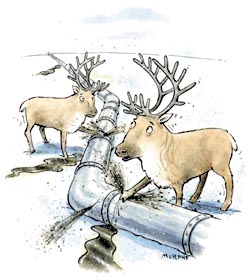Seeing the Light, Setting Standards and Piping Oil
I’ve heard that leaving a light on for a given length of time may use less energy than turning it off and on again. Is this a myth?
—Allison Nelson, Glen, NH
Leaving a light on to save energy is not a bright idea. This myth arose in the 1940s when energy was cheap and technologies were inefficient. Turning fluorescent lights off for longer than five seconds saves more energy than leaving them on. Turning off an incandescent light bulb starts saving energy after three seconds; halogen lights, after five minutes.
The life of a fluorescent bulb does decrease by a few hours with frequent switching. But turning the bulb off can increase its calendar life by years. "The energy savings from turning a light off for a brief period of time greatly outweigh any minuscule reduction in the bulb’s life span," says Bill Prindle, director of the Alliance to Save Energy’s Buildings and Utilities Program. The monetary savings can be significant, too. Just one extra hour a day of unnecessary lighting can increase electricity costs by five to 10 percent per month, according to the Utah Office of Energy Services.
CONTACT
Alliance to Save Energy
Tel: (888) 878-3256
What are the criteria used to determine whether genetically modified food is safe for human consumption?
—Barbara MacMath, Trumbull, CT
Currently, genetically modified foods do not receive special treatment. In 1992, the Food and Drug Administration (FDA) recognized these foods as safe and decided that the technologically tweaked plants would not be regulated as food additives. It established voluntary, not mandatory, consultations for companies wanting to market such foods. The agency concluded that labeling was not required because genetic engineering (GE) did not change a food in any "material" way. Last April, after conducting a study on plants engineered to produce their own pesticides, the National Academy of Sciences cautiously endorsed the safety of biotech foods on the market. But the academy also called for stronger regulation.
Scientists and consumers demand stronger regulation as well, especially after genetically engineered corn not approved for human consumption was found in several brands of taco shells. The FDA subsequently proposed rules that would strengthen scrutiny of biotechnology, but deemed mandatory labeling unnecessary.
"We aren’t satisfied with the new proposals," says Juliana Jones, product manager at the Center for Food Safety. "We don’t believe that there’s enough evidence to prove that [GE foods] are safe." The Organic Consumers Association agrees, calling for a global moratorium and further testing.
An estimated two-thirds of the processed foods on American supermarket shelves today contain genetically altered ingredients.
CONTACT
Organic Consumers Association
Tel: (218) 226-4164
How many spills has the Trans-Alaska Pipeline had on land and sea, and how has that impacted wildlife?
—Jeff Russell, Fairbanks, AK

Chris Murphy Illustration
Although researchers have collected data on pipeline-related spillage, they find it nearly impossible to document the scope of its impact, such as habitat fragmentation, on area wildlife.
The Trans-Alaska Pipeline transports about two million barrels of oil each day between Prudhoe Bay on the Arctic Ocean and the port of Valdez in the Gulf of Alaska. According to historian David Schwalbe, a tenth of all oil that Americans use daily passes through the pipeline.
Even before the first drops of oil left Prudhoe Bay on June 20, 1977, the Trans-Alaska Pipeline raised environmental concerns. "During construction alone, the total spillage of oil and petroleum products equaled 560,000 gallons," says Ross Coen of the Alaska Forum for Environmental Responsibility.
The spillage rate has accelerated. From 1989 to 1999, the three largest oil companies in Alaska (BP, Arco and Alyeska) combined for a total spillage of 2,053,526 gallons of hazardous materials, according to Coen. The Prudhoe Bay oil fields and Trans-Alaska Pipeline have caused an average of 409 spills annually on the North Slope between 1996 and 1999, says the Alaska Department of Environmental Conservation. A wide variety of substances, ranging from acid to waste oil, are spilled during routine operations.
CONTACT
The Alaska Wilderness League
Tel: (202) 544-5205

